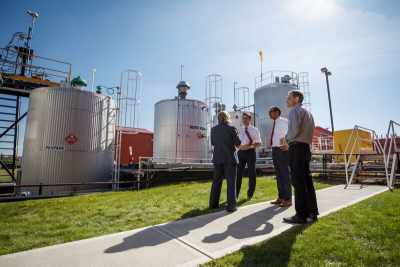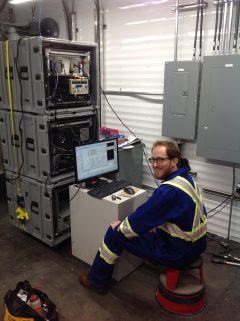 Earlier this month, Prime Minister Justin Trudeau and Natural Resources Minister Amarjeet Sohi toured CanmetENERGY’s Devon Research Centre in Alberta, which is the test site for a novel emissions measurement technology being developed by Carleton’s Energy and Emissions Research Lab (EERL). The CanmetENERGY facility focuses on technologies and processes to reduce impacts of oil and gas development. In a unique collaboration between NRCan and Carleton researchers, we are researching innovative techniques to detect and quantify fugitive and vented hydrocarbon sources in the upstream oil and gas sector.
Earlier this month, Prime Minister Justin Trudeau and Natural Resources Minister Amarjeet Sohi toured CanmetENERGY’s Devon Research Centre in Alberta, which is the test site for a novel emissions measurement technology being developed by Carleton’s Energy and Emissions Research Lab (EERL). The CanmetENERGY facility focuses on technologies and processes to reduce impacts of oil and gas development. In a unique collaboration between NRCan and Carleton researchers, we are researching innovative techniques to detect and quantify fugitive and vented hydrocarbon sources in the upstream oil and gas sector.

Ph.D. candidate Simon Festa-Bianchet with the OTEMS technology control station which operates remotely from the Carleton Energy and Emissions Research Lab (EERL) in Ottawa
Prime Minister Trudeau and Minister Sohi visited a prototype laser-based optical technology for measuring liquid storage tank emissions. This first generation of the Optical Tank Emissions Measurement System (OTEMS) has been installed in Devon, Alberta since 2016 on a 150 barrel pentane tank and is remotely operated by EERL researchers from Carleton University. Liquid storage tanks are a key source of methane and volatile organic compounds (VOCs) throughout the oil and gas sector. Current emission estimates are based on a semi-epirical model developed in the Unites States using limited data to validate its applicability which are questionably relevant for a colder Canadian climate. Research is focused on developing a novel Canadian measurement technology that will be uniquely capable of direct emissions flux measurements on one of the most critical energy sector sources. This exciting project is the subject of Ph.D. student Simon Festa-Bianchet’s thesis work, the ultimate goals of which are to develop improved emissions models and inventories, suport effective standards, regulations and best management practices, and enable quantified mitigation actions.